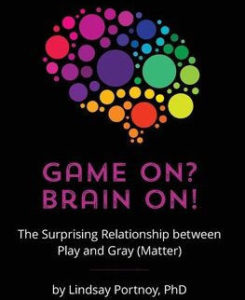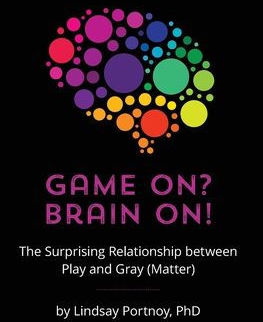Game on? Brain On!: The Surprising Relationship between Play and Gray (Matter) is an affectionate, evidence-based, tribute to the importance of play for learning and preparing young people for their future. Author Lind say Portnoy, who currently serves as an Associate Teaching Professor at Northeastern University, argues that we are born to play and that games can be an ideal space to develop skill in solving problems, thinking critically and creatively, persevering, collaborating, communicating, and empathizing. Portnoy argues for the value of play for supporting each individual student’s learning and for addressing equity issues in education. Throughout the book and on her website she offers tools to support educators in transitioning to more play-based learning exercises for students and urges educators to push back against rigid, putative learning cultures and standardized assessments. Especially amidst the COVID-19 pandemic when students miss their friends and may find online learning to be exhausting and when teachers are seeing anew how challenging standardized curricula can be, we could better serve our students by absorbing Portnoy’s lessons about how to harness the power of play. As such, Game On? Brain On! will be of interest to an array of K-16 educators and education reformers.
say Portnoy, who currently serves as an Associate Teaching Professor at Northeastern University, argues that we are born to play and that games can be an ideal space to develop skill in solving problems, thinking critically and creatively, persevering, collaborating, communicating, and empathizing. Portnoy argues for the value of play for supporting each individual student’s learning and for addressing equity issues in education. Throughout the book and on her website she offers tools to support educators in transitioning to more play-based learning exercises for students and urges educators to push back against rigid, putative learning cultures and standardized assessments. Especially amidst the COVID-19 pandemic when students miss their friends and may find online learning to be exhausting and when teachers are seeing anew how challenging standardized curricula can be, we could better serve our students by absorbing Portnoy’s lessons about how to harness the power of play. As such, Game On? Brain On! will be of interest to an array of K-16 educators and education reformers.
Drawing on neurodevelopmental research Portnoy first argues that people come into the world ready to learn. Play is a natural way of facilitating learning by capitalizing on our intrinsic interests in a low-stakes, imaginative context. Portnoy offers numerous examples of games that students enjoy playing and can be educational—from commercially available board games (e.g., Monopoly), to video games (e.g. Fortnite), to physical games at recess (e.g., wall ball), to student or teacher invented games. By observing and probing students about their play while letting the students take the lead, educators can learn a lot about those students’ skills and interests. Simultaneously, they can support the students in developing critical skills such as executive functioning, emotional regulation, convergent and divergent thinking, and metacognition. Among the benefits of play are that it does not ask of students the same high degree of conformity and compliance that classrooms typically do and it draws on students’ strengths rather than admonishing them for their weaknesses.
Classic psychological motivation theories support Portnoy’s call for more game play. While playing games students can experience a sense of competence, autonomy, and connectedness with peers. Games allow students and their playmates to try on different roles creating a safe way to express different parts of themselves, opportunities to draw on peers’ expertise as sources of support and guidance, and a scaffolded context for building empathy. Cognitive psychologists and learning scientists know well that distributed, interleaved practice of skills supports long-term retention. Games encourage recursive practice, and they frame failure as an opportunity for feedback and growth, which supports learning.
Although educators do not often use games as a tool for assessment, games can be effectively harnessed as a way for students to demonstrate what they know and how they can continue to grow. Portnoy urges educators to consider employing reflection about experiences with games or other active learning exercises as a mode of assessment.
Citing examples of several games that are addressing pressing issues, Portnoy notes that through games students may be able to make authentic contributions to real problems in their community or in our society. Further, in school we often divide students by age or ability, but games are conducive to having players of all different ages, interests, and abilities work together, which can offer important social learning opportunities for students.
Children will always play. If we paid less attention to what students play and learn and more attention to how they play and learn, we might be able to bring out the best in our learners by capitalizing on their passions to inspire their continued growth.
Portnoy, L. (2020). Game on? Brain On!: The surprising relationship between play and gray (matter). Dave Burgess Consulting, Inc.


